Price, in business trade is inevitably treated as a core key point, everyone wants to buy a cost-effective, affordable product. For street lamp manufacturers, the price of LED street lamps is also very concerned. In some cases, even more attention is paid to the quality of LED street lamps. However, it is cheap to pay attention to the price of LED street lamps. Once again, you are reminded of the outdoor street lamp buyers, remembering the price. A piece of goods, responsible for the outdoor streetlight project, do not be confused by the inferior products with low-priced slogans.

What are the prices of LED street lights? If calculated according to the price of the whole set of LED street lamps, the main price is divided into three parts: light source lamps, LED street lamp power supplies, and street lamp poles. In terms of subdivision, there are also ways to distinguish the size of the lighting, the speed of the light source and the brand. The LED street light power supply should distinguish between the brand and the wattage. As for the light pole, the height, material, thickness, etc., and other packaging costs, buried Cage is also a small part of the price. Overall, the price of LED street lamps is determined according to the specific needs of the configuration. There is no standard pricing. It seems that the price of led street lamps with the same style can often be matched with several different prices.
Different demand configurations correspond to different prices, so how to price LED street lamp manufacturers is suitable? Generally speaking, the LED street lamp industry is relatively mature now, and the price is more and more transparent. The LED street lamp engineering buyers also understand the price. In general, in addition to the total cost, plus 5%-10% of corporate profits is basically the final market-oriented price. The price of LED street lamps is also relatively simpler than the price of solar street lamps. It is also better to do calculation comparison. The price difference under the same configuration is getting smaller and smaller.
The price combination of LED street lamps is the same as most products. Generally speaking, the sales price of a physical product is generally composed of: raw materials, parts cost + labor cost + package transportation finished product + enterprise rent, machine accumulated depreciation expense + tax fee + enterprise profit = selling price. What we usually say is a discount. In fact, it is often a discount on corporate profits. How do you say this? Because the market economy is also the LED street light, in the case of the same quality of the same specifications, the cost of raw materials, labor, transportation and packaging, etc. are relatively close to each other, even the same cost. Assume that the LED street lamp products with a sales price of 1,000 yuan, of which the enterprise profits account for 10%, that is, 100 yuan, then the preferential treatment given by the enterprise is from the 100 yuan, and the company will not reduce the preferential rate to the preferential price. More than 100 yuan, the cost has been 900 yuan, and the selling price is less than 900 yuan, how can companies survive?
Similarly, if the market cost 900 yuan products, there is an LED street lamp manufacturer telling you that their sales price is lower than 900 yuan, then I can almost certainly tell you that they will not make profits in this part of the company's profits, generally It is to adjust the cost of 900 yuan. The market price is 1,000 yuan, the general cost of the market is 900 yuan, and the company's profit is 100 yuan. At this time, if the company wants to maintain a profit of 100 yuan, and the sales price is controlled at 900 yuan below the market cost, there is only one possibility, that is, its cost is less than 900 yuan. This also means that we often say cut corners and poor quality. I am here to point to it, I believe that everyone can understand what I want to express, all the sales prices below the general cost of the market are attractive inferior prices! Please stay away from it.
Then return to the composition of the price of LED street lamps, in addition to the operating costs of enterprises, the price of LED street lamps is basically = lamps with light source + overall hot-dip galvanized lamp pole + power supply + buried cage + manual, packaging, transportation. LED street lamp head is composed of lamp housing, reflector, lens (light cover), light source chip, etc. Different specifications, different brands and even different styles will have different prices. The thickness, material, height and so on of the pole of the pole Both are price factors, and the type of controller brand quality is also different. What I want to express is that the price composition of LED street lamps is determined according to the actual use requirements. At the same time, different brands have different quality. Before I consulted my LED street lamp price, I gave me a specific configuration. In the same configuration, I You can match at least 3 prices. Of course, the same configuration, different prices, depending on the quality brand, this is what I just mentioned, the kind of inferior goods with low-priced slogans. They will tell street lighting contractors, especially those with less experience, that their same configuration can be 30% cheaper than their peers, which is why. Let me give you a counterexample: the light source is a brand name, and the actual power is 20% lower than the power of the target. The cost of the light source is cheaper. Then the pole is made of non-integral hot-dip galvanizing, which is cheaper and thicker. It is thinner than the industry, and it is cheaper again. The power supply is cheaper than the non-intelligent constant current of the brand. Therefore, bargains are the way to do this. In the raw materials, cut corners, low-end inferior products on the core parts, the sales price can of course be sold lower than the cost price of the industry, but this is not responsible for the outdoor lighting project, such LED street lamp manufacturers are not responsible for the road engineering Responsible.
Outdoor lighting engineering and municipal unit purchasers will initially understand the price of solar street lamps and the price of LED street lamps. Why are outdoor street lamps, why the price of solar street lamps is more expensive than the price of LED street lamps, and it is not just expensive. Little by little.
First of all, take the price of solar street lights directly compared with the price of LED street lights, we found that both have the same place. The streetlight source used in solar streetlights is also LED. The quality of the light poles used is the same. One uses the power supply and one uses the controller. The price of these three points is not far behind, so the price difference is different at different points. On the components, solar street lights have several more things than LED street lights: solar panels, solar cells, and battery boxes.
Solar panels, the price depends on the quality. For solar street lamp manufacturers, the solar panels are calculated according to the wattage. The solar-specific batteries are also calculated according to the size AH. In general, the bigger the more expensive. For LED street lights, the higher the configuration, the place where the price needs to be increased is the lamps, the light poles, and the power supply. However, for solar street lights, the higher the configuration, the higher the cost of the solar panels, batteries, lamps, and poles. This is also the reason why the price of solar street lamps is more expensive than the price of LED street lamps.
Although the price of solar street lamps is more expensive than LED street lamps, considering the unique advantages of solar street lamps, there is no need to use electricity, intelligent working mode, free wiring installation, simple maintenance, etc. Even if the price is relatively expensive, it is still very popular in the market.
To sum up, the price of LED street lights is determined according to the actual use requirements. In addition, it is better not to choose a product that is obviously cheaper, and it is not cheap. In addition to LED street lights, solar street lights, solar lawn lights, wind-solar complementary street lights, solar garden lights and other outdoor lighting fixtures are also the same, the price is critical, but should not be the buyer only pay attention to the price and ignore the quality.
Aluminum Printed Circuit Board, Recognized Best Solutions for High Power and High Thermal Conductivity
As for Aluminum PCB , we will elaborate on the following aspects
- What is Aluminum PCB?
- More Detailed Introduction of Aluminium PCB
- Aluminum PCB Structure
- Aluminum PCB Advantages
- Aluminum PCB Applications
- Types of Aluminum PCB
- Aluminum PCB Performance
- Classification of Aluminum PCB
- Manufacturing Difficulties of Aluminum PCB
- Design Guidelines For Aluminum PCB
As a Chinese PCB manufacturer, Jinghongyi PCB has rich experience in manufacturing aluminium PCB Board . It provides customers with high-quality aluminium PCB Manufacturing and one-stop aluminium PCB turnkey assembly services, prompt delivery on time, and competitive prices.
What is Aluminum PCB
Among all metal core PCBs, Aluminum Core PCB is the most common type, also known as IMS (Isolated Metal Substrate). Due to its low cost, non-toxic and environmental protection, higher durability and lightweight characteristics, aluminum clad PCB is widely used, and its main task is to dissipate the heat generated by power components. For example, it is used in high-power LED lighting power supply, power module, automobile power controller, computer CPU motherboard, etc.
According to the different design structure and application scenarios of aluminium PCB, there are mainly Flexible aluminium PCB, mixed aluminium PCB, multi-layer aluminium PCB, through-hole aluminium PCB and so on.
More Detailed Introduction of Aluminium PCB
Using heat-sinks increases the costs and makes assembly more difficult, and the extra weight and volume can cause problems.Safe and effective heat dissipation is very important in applications where high power components generate a lot of heat. Although forced cooling is a method, the disadvantage of forced cooling is that it produces disturbing noise, vibration and increased energy consumption while refrigerating. The use of additional radiators increases costs and makes assembly more difficult, and additional weight and volume can cause other unnecessary problems.
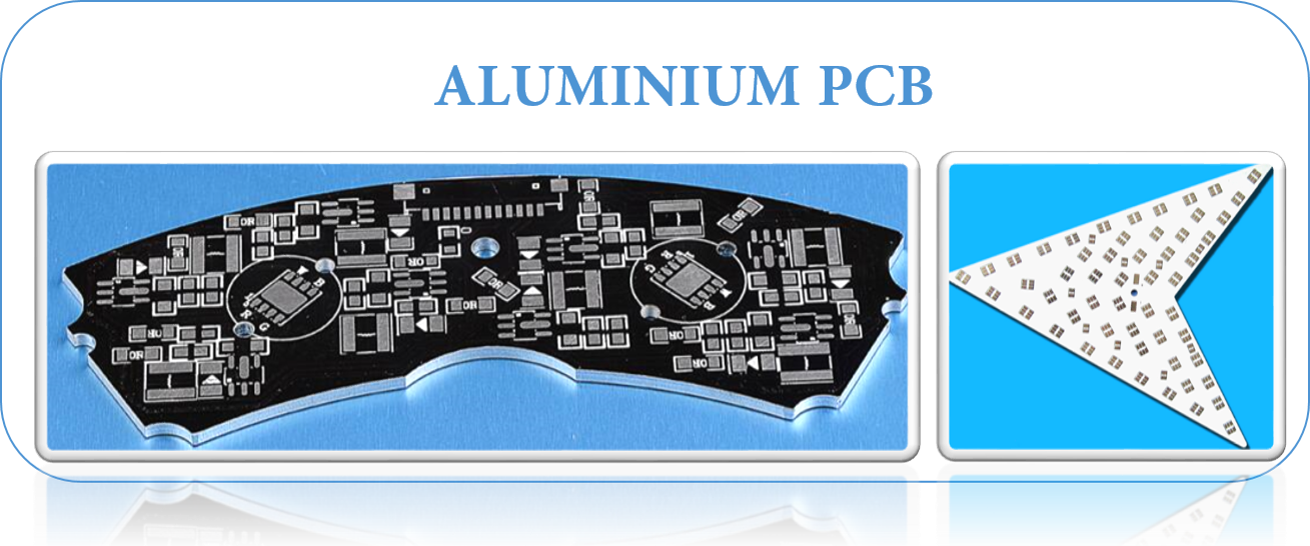
Using a specific PCB structure is usually a better solution. The commonly used solution is the metal core structure. With this solution, the printed circuit board is composed of aluminum plates bearing track patterns. Thermoelectric insulators are used between the track and the board so that heat can pass through the metal core structure, such as the Metal Core PCB .
While LED lighting is widely used, it is also necessary to eliminate the heat generated by LED lighting. Therefore, the development of LED lighting industry directly leads to the increase of PCB using aluminium core. At the same time, the market demand of LED PCB Board is also growing.
Copper may be used as an alternative.
For high-power LED, most customers use aluminum-based PCB; for low-power LED, standard Fr4 PCB is also available. Our PCB manufacturing specifications and construction of most types of metal-based Printed Circuit Boards.
Aluminum Based PCBs are a unique metal-based copper clad laminate. These types of Printed Circuit Boards have good thermal conductivity, electrical insulation and very solid machining performance.
They are also known as Aluminum Clad, Aluminum base, MCPCB (Metal Clad Printed Circuit Board), IMS (Insulated Metal Substrate), Thermally Conductive PCBs etc. Aluminum PCBs were developed in the 1970s, soon after which they`re applications increased dramatically. The first application was their use in Amplification Hybrid Integrated Circuits. Now they are being used at a large scale due to which it is necessary for us to have an idea of Aluminum PCBs and their importance.
Aluminum PCB Structure
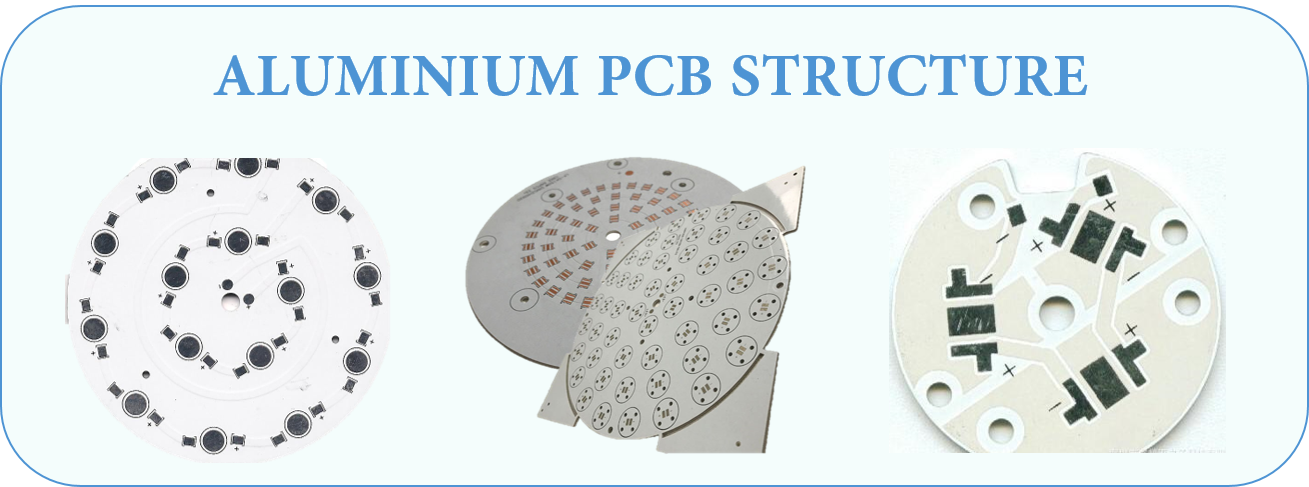
AluminumPCBs are actually quite similar to FR4 PCBs. The basic structure of Aluminum PCBs is four layered. It consists of a layer of copper foil, a dielectric layer, an aluminum base layer and aluminum base membrane.

- Copper Foil Layer: the copper layer used is relatively thicker than normal CCLs ( 1oz-10oz). A thicker layer of copper means a larger current carrying capacity.
- Dielectric Layer: the Dielectric layer is a thermally conductive layer and is around 50μm to 200μm thick. It had a low thermal resistance and it suitable for its application.
- Aluminum Base: The third layer isthe aluminum base which is made up of aluminum substrate. It has a high thermal conductivity.
- Aluminum Base Membrane Layer: Aluminum base membrane is selective. It has a protective role by keeping the aluminum surface safe from scraping and unwanted etching. It is of two types i.e. Lower than 120 degree or around 250 degrees (anti high temperature)
Aluminum PCB Advantages
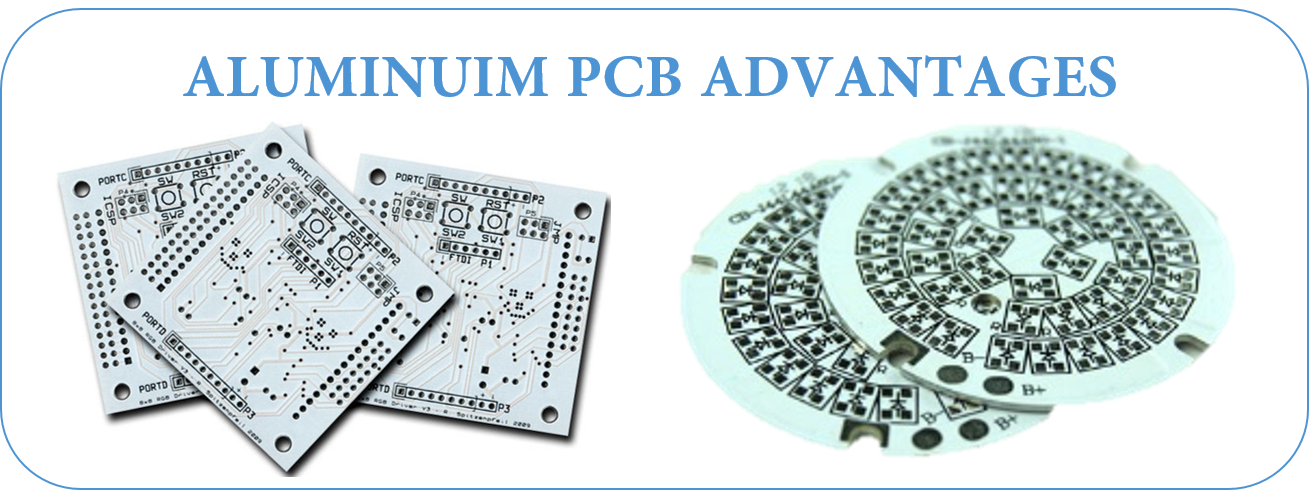
- Lower manufacturing and use costs: Aluminum is a metal that can be found in a variety of climates, so it is easy to mine and refine. Therefore, the costs of doing so are significantly lower than other metals. In turn, this means that manufacturing products with these metals are less expensive as well.Aluminum is a very common metal raw material, its mining and production are very convenient. Therefore, the cost of doing so is significantly lower than that of other metals. Conversely, this means that products made from these metals are also cheaper.
- More energy-saving and environmentally friendly: Aluminum is non-toxic and recyclable. Because it is easy to assemble, the use of aluminium also helps to save energy. For PCB vendors, the use of this metal helps to maintain the health of our planet.
- Better heat dissipation performance:Efficient heat dissipation is the greatest advantage of aluminium PCB. High temperature can cause serious damage to electronic equipment, so it is wise to use materials that can help heat dissipation. Aluminum can actually transfer heat from important components to minimize its harmful effects on circuit boards.
- Higher strength and durability: Aluminum provides strength and durability to a product that ceramic or fiberglass bases cannot. Aluminum is a sturdy base material that can reduce accidental breakage during manufacturing, handling, and everyday use.
- Lighter weight and better elasticity: Aluminum is widely recognized as a light metal. While increasing the heat dissipation performance of high power components, it also reduces the weight of the product itself, and increases the strength and elasticity. In addition, in the transportation of products, lighter weight also saves the transportation cost of products.
- Higher conductivity: Thermal conductance of dielectic used is 5 to 10 times higher than old epoxy glass.
- More effective and reliable: Thermal transfer is more efficient and reliable than regular PCB.
Aluminum PCB Applications
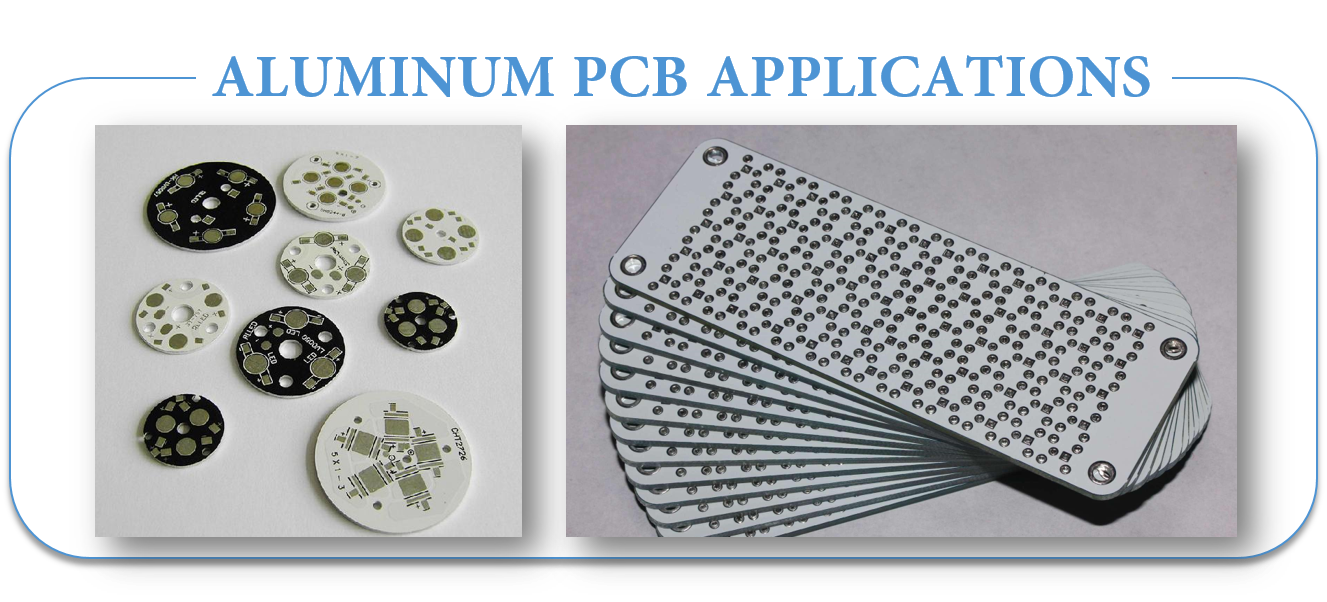
- Audio device: Input, output amplifier, balanced amplifier, audio amplifier, pre-amplifier,power amplifier.
- Power Supply: Switching regulator, DC / AC converter, SW regulator, etc.
- Communication electronic equipment: High-frequency amplifier, filtering appliances,transmitter circuit
- Office automation equipment: Motor drive, etc.
- Automobile: Electronic regulator, ignition, power supply controller, etc.
- Computer: CPU board, floppy disk drive, power supply devices, etc.
- Power Modules: Inverter, solid state relays, rectifier bridges.
- Lamps and lighting: As the advocated promotion of energy-saving lamps, a variety of colorful energy-saving LED lights are well received by the market, and aluminum pcb used in LED lights also begin large-scale applications.
Types of Aluminum PCB
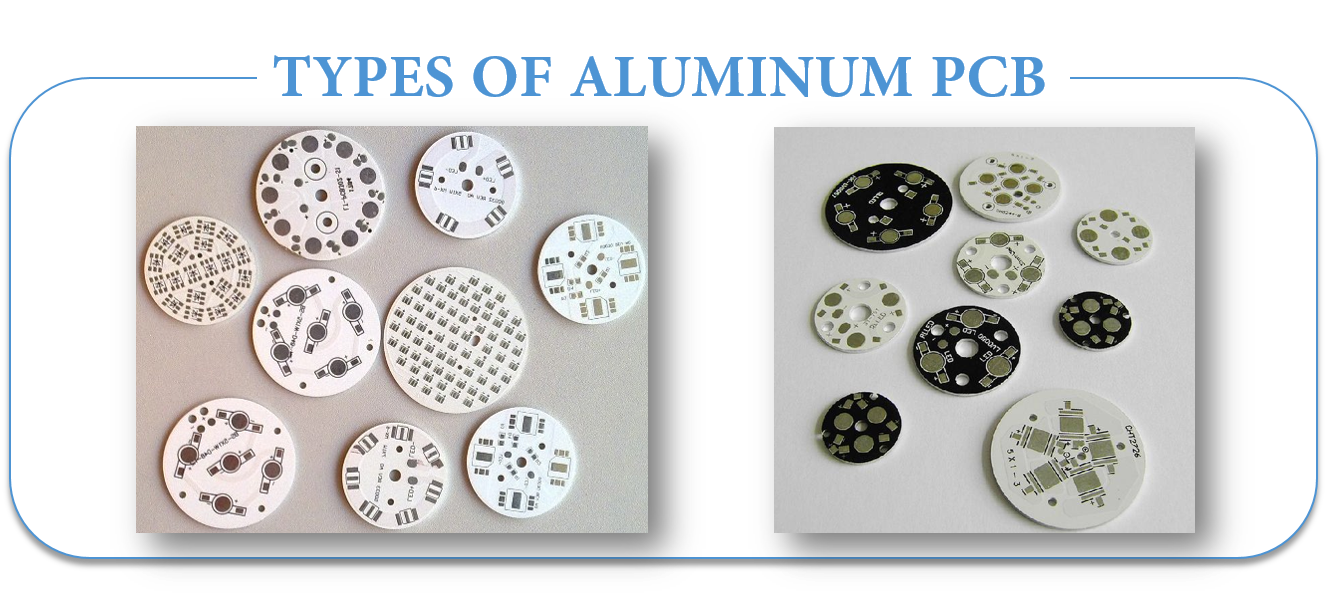
-
Flexible Aluminum PCB
Firstly, Flexible aluminium PCB is a new flexible dielectric developed in the development of aluminium products. It is also a kind of flexible circuit board. Because of the combination of polyimide resin and ceramic filter, it has high flexibility, thermal efficiency and excellent electrical insulation. When used in aluminium PCB products, the expensive cables and connectors no longer need to be used.
Flexible circuit boards have unparalleled flexibility, so flexible aluminum PCB can be arbitrarily folded, twisted or formed in any other desired form. However, it should be noted that once a specific shape is formed, it can no longer be changed like other conventional flexible circuit boards. Or deform.
-
Hybrid Aluminum PCB
In hybrid aluminum construction, non-thermal material is processed and refined separately before it is applied to the thermal materials with aluminum base.
The most common practice is developing 2 layer or 4 layer structure which comprises of FR4 material.
A non thermal material that is bonded with thermal material and aluminum base provides rigidity and helps in the dissipation of heat.
This non thermal bonding is preferred over using all thermal materials because it features less cost and encompasses efficient thermal conductance over regular FR4 products.
No heat sinks or assembly steps are required for the development of this product.
Through hole components can be easily adjusted using component windows on the aluminum base.
This helps in passing the cables and connectors through substrate. Also the seal created by solder fillet eliminates the need of costly adopters.
-
Multilayer Aluminum PCB
Multilayer Aluminum PCBs are very common in power supply products and come with multiple layers of thermally conductive dielectrics.
These materials are very useful when they are combined with one or more layer of circuitry in which thermally conductive dielectric is buried between the layers with the help of blind vias which also act as a signal or thermal vias.
Single layer construction of these designs is not very effective, however, when they come with more complex designs they provide an ideal solution for many applications involving heat dissipation.
-
Through Hole Aluminum PCB
When it comes to most complex constructions, a single layer of aluminum is back-filled and pre-drilled with before applying lamination, forming a Core of a multilayer constructions.
Thermal bonding materials are then used to laminate the thermal materials on both sides of the aluminum.
Once lamination is done, drilling is applied on the assembly.
In order to maintain proper electrical insulation, the plated through holes created as the result of drilling must pass through aluminum clearances.
Aluminum PCB Performance
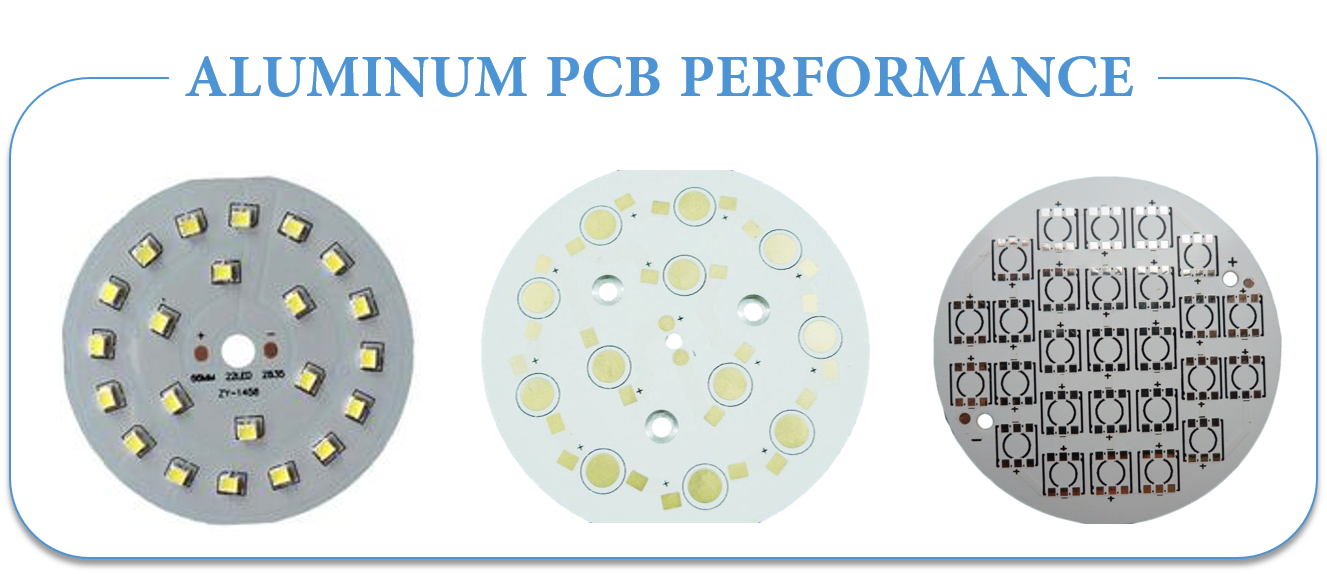
- Better heat dissipation and conductivity: Compared with ordinary FR4 PCB, aluminium PCB has excellent heat dissipation performance. For example, Fr4 PCB with a thickness of 1.5mm will have a thermal resistance of 20-22 degrees per watt, while aluminium PCB with a thickness of 1.5mm will have a thermal resistance of 1-2 degrees per watt.
- There is no serious problem of thermal expansion or contraction.: each substance has its own coefficient of thermal expansion. The CTE of aluminum (22ppm/C) and copper(18ppm/C)is quite close. Since aluminum PCBs work well in terms of Thermal dissipation they do not have severe expansion or contraction issues. They work excellently and are durable and reliable.
- Dimensional Stability: aluminum PCBs show dimensional stability and stable size. For example, when they are heated from 30-140 degrees, their size only had a change by 2.5%-3.0%.
- Others: Aluminum PCBs can be used in power device surface mount technology. They are effective for use in circuit design because of their performance in terms of thermal expansion of circuit design. They help to prolong products shelf life and product power density. They are also extremely reliable. They can help to shrink the overall volume of the product and is also a cheaper option. They show electromagnetic shielding and high dielectric strength.
Classification of Aluminum PCB
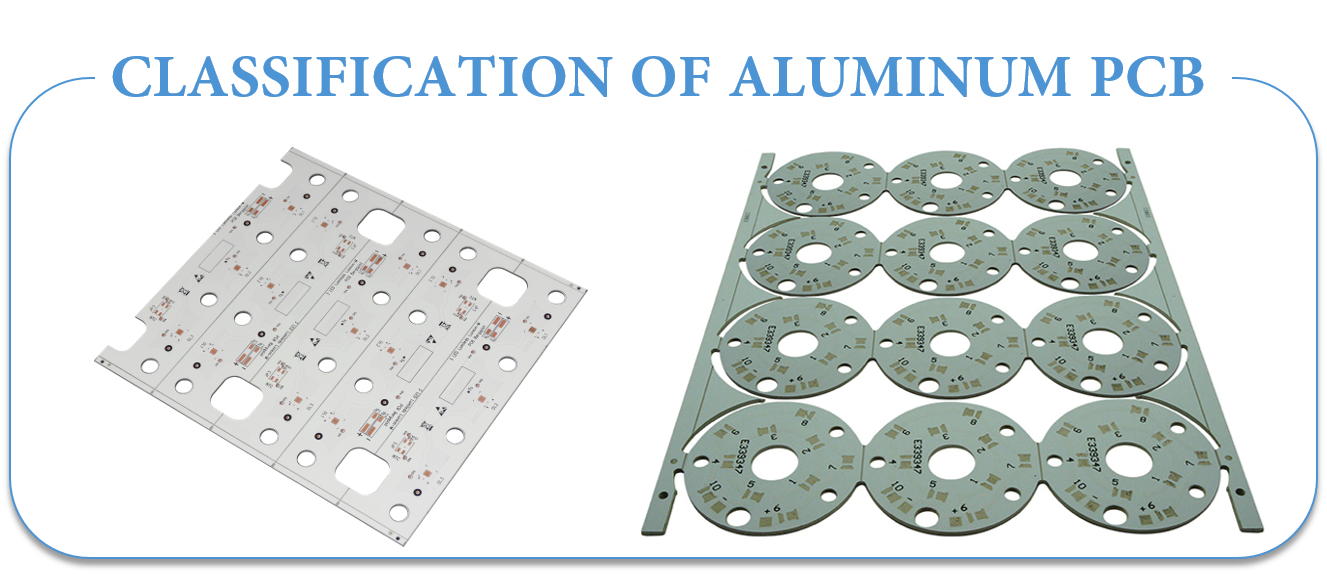
- Universal Aluminum PCB: the dielectric layer used here is made up of epoxy glass fiber pre-preg.
- High Thermal-Conductive Aluminum PCB: the dielectric layer is made up of epoxy resin. The resin used must have high thermal conductivity.
- High-frequency Aluminum PCB: the dielectric layer is composed of polyolefin or polyimide resin glass fiber pre-preg.
Manufacturing Difficulties of Aluminum PCB
The manufacturing process for nearly all aluminum PCBs is essentially the same. Here we will discuss the major manufacturing processes, the difficulties and their solutions.
- Copper Etching: the copper foil used in Aluminum PCBs is comparatively thicker. If the copper foil is over 3oz however, the etching requires width compensation. If it is not according to the demand of the design, the trace width will be out of tolerance after etching. Therefore the trace width compensation should be designed accurately. The etching factors need to be controlled during manufacturing process.
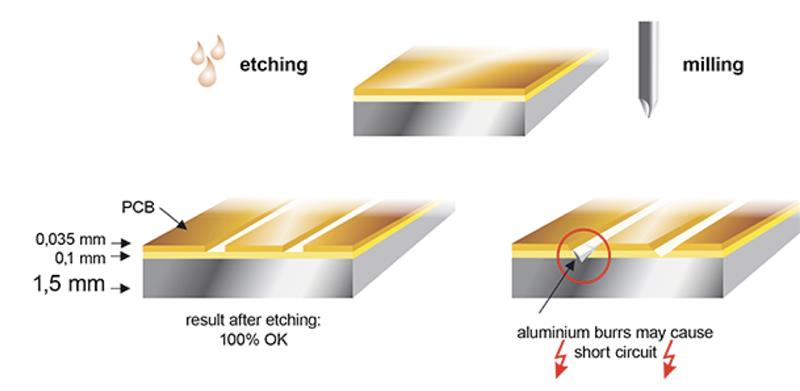
- Solder Mask Printing: due to the thick copper foil there is a difficulty in solder mask printing of aluminum PCB. This is because if the trace copper is too thick then the image etched will have a large difference between trace surface and base board and solder mask printing will be difficult. Therefore, the two-time solder mask printing is used. The solder mask oil used should be of good quality and in some cases the resin filling is done first and then solder mask.
- Mechanical Manufacturing: the mechanical manufacturing process involves mechanical drilling, molding and v-scoring etc. which Is left on internal via. This tends to reduce electrical strength. Therefore, the electric milling and professional milling cutter should be utilized for low-volume manufacturing of products. The drilling parameters should be adjusted to prevent burr from generating. This will help your mechanical manufacturing.
Key Requirements When Selecting an Aluminum PCB Manufacturer
For the most part, all PCB manufacturing follows the same production process regardless of where they are made. The only true differences in suppliers is the level of automation in their process, the newest technology and equipment, and having specific equipment designed to focus on certain types of end products.
For aluminum PCBs, there are several key items that a PCB manufacturer needs to consider if they are going to be able to effectively produce aluminum PCBs in any quantity, including:
- Dedicated Imaging Equipment
Many of our aluminum backed PCBs go into LED applications that are much longer than the standard 18" x 24" or 20" x 24" production panels used in traditional PCB manufacturing. To be able to accurately register and economically produce these parts, a manufacturer must have either a custom piece of 60" wide UV light imaging equipment or a setup capable of screen printing (at one time) an image and then UV curing through an oven.
The old manufacturing process of screen printing half the image and then trying to hand register the first image while screen print the second half is much less effective.
- Specialized Scoring Equipment
The more common equipment that can V score through traditional FR-4 materials is not suited to manage aluminum PCBs. To get the lowest cost possible, we need to get the best yield possible, which means we need to be able to place these parts as close as possible to each other on the production panel. Without V scoring, you must mechanically rout the parts out, which could result in up to 20% loss of your yield, subsequently increasing cost.
Our engineering team has many years of experience helping our customers design arrays that are the most cost effective for them to depanelize.
- Greater Than 40-ton Punch Presses
For aluminum PCBs that are round or have unique features – (slots, large holes, cutouts, etc.) – you will want a manufacturer that can punch out these features. Trying to mechanically rout aluminum PCBs is a very costly way to get these features done in a production environment.
- In-Line Hi-Pot Test
A unique requirement of aluminum PCB is that customers want to know that the product they are getting has passed a hi-pot test. While most PCB manufacturers can do this, it is usually a separate process in a lab that is not located in electrical testing. Epec`s electrical test set up includes a hi-pot test, which dramatically reduces cost for the customer.
The following table presents some of our Aluminum Core materials:
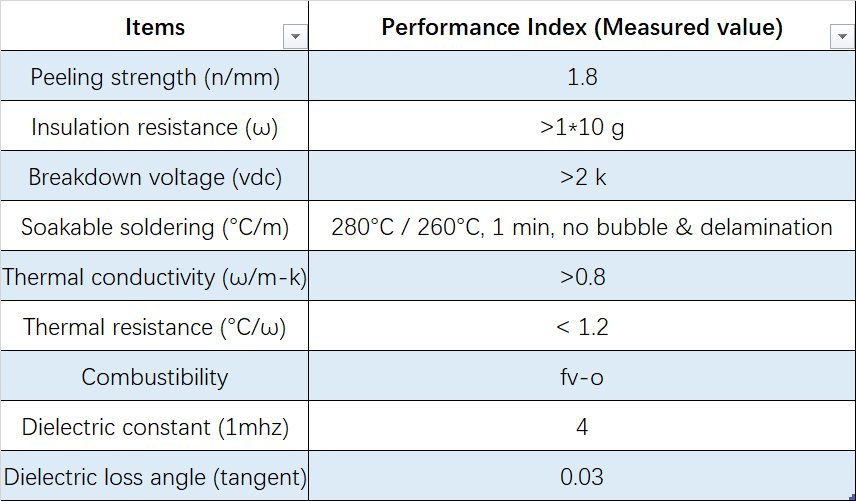
Check our Aluminum core PCB manufacturing capabilities in the following table:

Design Guidelines For Aluminum PCB
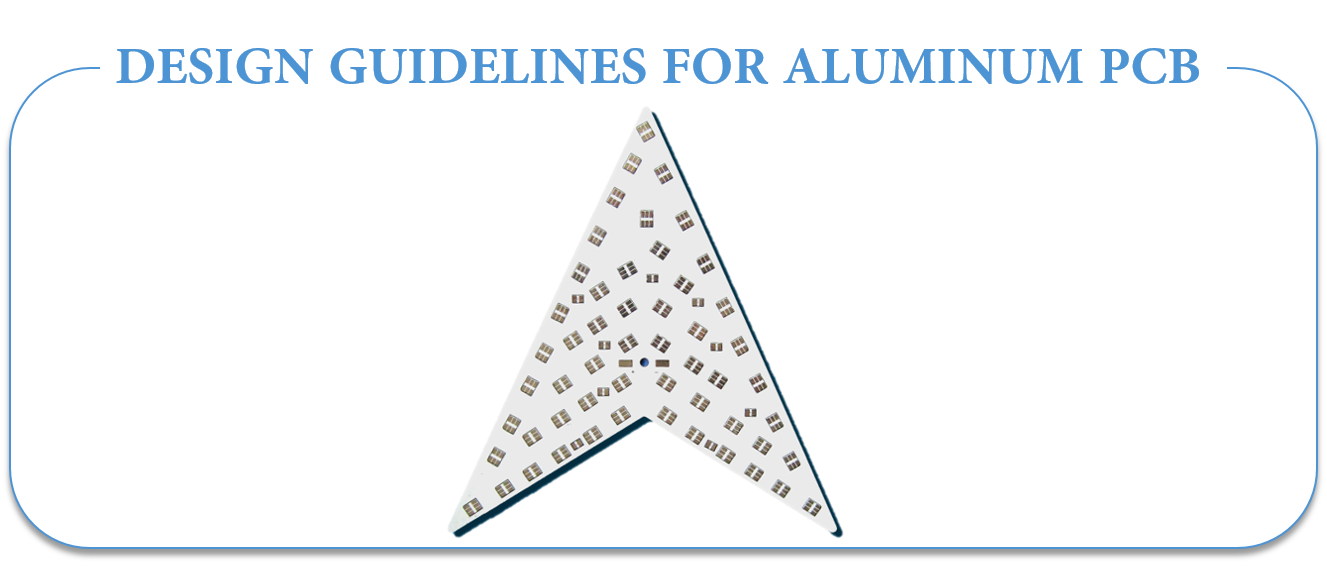
The task of aluminum core circuit board is to dissipate the heat generated by power components. Therefore, we recommend installing pure power components in this part of the circuit. The control unit shall be installed on a separate standard PCB.
Drilling distances and diameters
In case of double-sided aluminium-core circuits, the aluminium core must be insulated against throughplating. This is done using an excess of resin when press-moulding the aluminium core with prepregs and copper or by plugging. To this end, the aluminium core must be pre-drilled.
The smallest drilling diameter in the aluminium core is 1,0 mm, the smallest final diameter in the PCB is 0,3 mm. So that the drills are not damaged in these close-set drill holes, a minimum spacing of 1,2 mm is required. This is generally the knock-out criteria for a densely-packed control unit.
Variants of aluminium core circuits
-
Single-sided PCBs on aluminium carriers
Normally, this variant only has drill holes for fastenings.
-
Multilayer PCBs with aluminium core
Copper foils are laminated onto both sides of an aluminium core using prepreg. The PCB can be through-plated. This means that it is also possible to produce multilayers with a 0,5 mm aluminium core.
-
PCBs on metal heat-conducting sheets
Completed PCBs are press-moulded to an aluminium carrier using a prepreg. Benefit: Multilayers can also be used (only single-sided SMD). Partial aluminium carriers are possible. Disadvantage: Poor heat dissipation, as the heat has to be dissipated through the entire PCB.
-
Aluminium-flex
One further possibility is a rigid- Flex PCB structure, where the aluminium carrier works as the rigid area of the PCB. This means that it is also possible, for example, to connect a control unit as a plug connector over the exposed flex area.
Basics of Heat Transfer
At a basic level, a discussion about heat transfer includes two topics: temperature and heat flow. Temperature represents the level of thermal energy that`s available, while heat flow represents thermal energy movement from one place to another.
Microscopically, thermal energy is directly related to a molecule`s kinetic energy. The greater the temperature of a material, the greater the thermal agitation of its molecules. It`s normal for areas that contain a lot of kinetic energy to pass it along to areas with less kinetic energy.
There are some material properties that effectively modulate heat that`s transferred between two areas at different temperatures. These include thermal conductivities, material densities, fluid velocities and fluid viscosities. Together, these properties make resolving many heat transfer problems pretty complicated.
The Mechanisms of Heat Transfer
Heat transfer mechanisms can be grouped into three broad categories:
- Conduction. Areas that have more molecular kinetic energy will send their thermal energy to areas that have less molecular energy. This occurs through a direct collision of molecules, known as conduction. In metals, some of the energy transported from one area to another is also carried by conduction-band electrons.
- Convection. When heat is generated in an electronic device, it`s transported via conduction to an are where it is then transferred to a fluid. That process is convection, and the fluid can take the form of a gas such as air or conventional water.
- Radiation. All materials give off thermal energy in amounts that are determined by temperature. When the temperatures are uniform, the radiation flux is in in equilibrium between objects, and there is no exchange of thermal energy. This balance changes when temperatures vary and thermal energy is transported from areas of higher temperatures to those of lower temperature.
HELP RESOURCES
Quick Turn Aluminum PCB
Aluminium PCB Board for LED
Aluminium Base Metal Core PCB
Aluminum PCBs vs. Standard PCBs
Using aluminium in Flexible Circuits Board
Things You Need To Know About Aluminum PCBs
Aluminum PCB
Aluminum PCB,Aluminum PCB Led,Aluminum Core PCB,Aluminum Circuit Board
JingHongYi PCB (HK) Co., Limited , https://www.pcbjhy.com